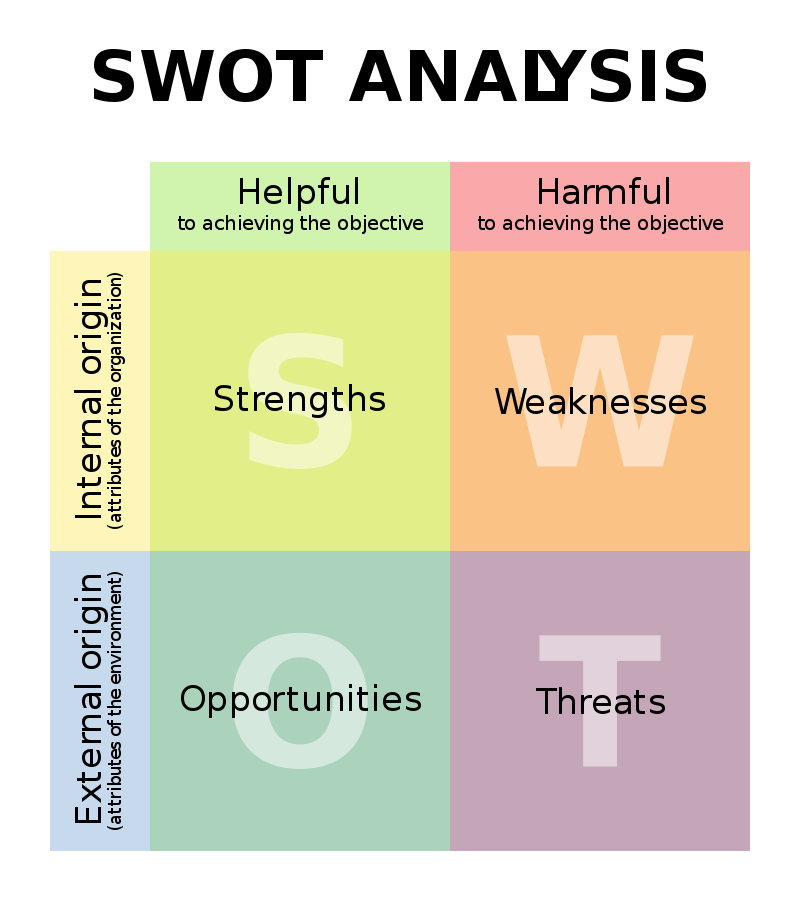This post is the first in a series of guides to help our readers better prepare for their EIC grant proposals. You can check this series of posts here or ask us for an evaluation here.
Many people do not know how to properly do a SWOT analysis. Unfortunately, that is why this relatively basic tool is often overlooked, even in the business world. There are even CEOs that thought badly of it, but came around and now swear by it after reevaluating and realizing they were using it wrong! In this post, we help you make the most out of this simple tool. So, your business may grow and your project proposal may succeed, if you’re submitting one.
A SWOT analysis is one of the most well-known tools for business and strategic planning. It focuses on internal and external factors of a business, divided between positive and negative aspects. The positive aspects are Strengths and Opportunities, while the negative aspects are Weaknesses and Threats. Strengths and Weakness are internal aspects, while Opportunities and Threats are external aspects, hence the SWOT acronym.
While it is one of the most prominent analysis types in business, there is still much confusion about it. This is particularly true regarding the Opportunities quadrant. Ordinarily, people assume Opportunities to mean possible projects, i.e., opportunities to do something, instead of present circumstances that can improve the company’s or the project’s situation.
Filling a SWOT matrix
While having only four quadrants, a SWOT analysis can be filled in different ways. The most usual way fills the quadrants in the order the acronym presents them: Strengths, Weaknesses, Opportunities and Threats. This order leads people to think of internal aspects of the project first. Filling the SWOT matrix in this way, however, has garnered growing criticism. In this regard, specialists defend that thinking of the internal aspects of the project first can lead to shortsightedness and inability to see the bigger picture.
These critics defend that, instead, the filling of the matrix should begin with external aspects, that is Opportunities and Threats (no matter which one is first). This would help see the bigger picture. Then, the focus should turn to internal aspects. That way, the project is seen from the outside in. First looking at the environment it is situated in, so that the project’s particularities can then be observed.
The way one fills out the SWOT, however, is a matter of preference.
It is also important to be specific when filling out a SWOT matrix. Avoid one- or two-word descriptions, as they are too vague and not appropriate for a proper analysis. For instance, the word “price” could be put into every quadrant, each with a different meaning, but bringing no clarity to the analysis. “Price” as a Strength could be a low product sales price. On the other hand, as a Threat, it could be competitors’ prices or their ability to leverage their prices to undercut your company and so on. Short, descriptive sentences presented as bullet points are key to a lean, but still effective, SWOT analysis, that could later be expanded upon.
Strengths
As already mentioned, Strengths are internal positives aspects of your project. Meaning: they are your projects strong points, even if you don’t take the ecosystem into consideration. They can be things like high-quality products, skilled staff, proprietary technologies, a strong brand, among others.
Strengths are things in your control that either provide you with an advantage or make you stronger in some aspect. Some examples are:
- “not only is our process the most economic so far, but our patents ensure the safety of their use from competitors”,
- “our CEO is a known name in the tech industry, making end-users have confidence in our gadgets’ quality”,
- “our size and vertical integration make our production costs low, so we can provide the cheapest product and the best cost-benefit”.
Weaknesses
Weaknesses are internal negative aspects. They are areas within your business that need to be addressed, in which you are inferior to the competition or that could provide roadblocks in the future. Addressing Weaknesses can sometimes be mentally taxing, as they are issues theoretically within your control, leading to an idea of failure. However, all organizations have Weaknesses and, more importantly, addressing them will spur improvements.
Weaknesses can be things like high turnover rate, bad communication inside the company, resource limitations, weak points in products where the competition excels, etc. Notice how in both Strengths and Weaknesses, even if you mention the competition, the Strengths and Weaknesses are in your control. Some examples are:
- “we only sell our product in one retail chain, while most competitors sell in at least three”,
- “our video platform has no space for short-form content, which is a growing market segment”,
- “our low profit margin could jeopardize our ability to keep prices competitive”.
Opportunities
They are positive external factors to your project/company that could allow it to grow, expand or otherwise make its position stronger. They are not possible projects. Instead, they are more like beneficial circumstances. For instance: there is a new legislation that requires an environmental certification. Then, already having that certification would represent an opportunity, as it would bring a first-mover advantage in that market segment.
Opportunities can be things like lack of competition in a market segment, a new emerging market, an untapped or under-serviced market segment, positive media coverage, etc. Some examples are:
- “our pie tins have become popular as flying disks thrown in games”,
- “our partnership with local colleges provides us with highly qualified interns and professionals”,
- “the growing environmental concern improves our standing as electric car manufacturers”.
Threats
They are external factors that could negatively impact the project/company. Things like regulatory changes, negative media coverage, supply chain disruptions, natural disasters and emerging competition. Some examples are:
- “the current availability of lithium hinders the production of EV batteries”,
- “with the growing environmental concerns, we will have to discontinue our plastic products in time, especially straws, bags and bottles”,
- “due to our location in Japan, our nuclear power plant is highly vulnerable to earthquakes and tsunamis”,
- “the initial customer excitement about our virtual reality segment might cool down and as a consequence our company’s stocks can lower in value”.
Cross-analyzing quadrant data
For a simple SWOT analysis, this is it. However, for an EIC proposal, you need to do additional analyses by cross-analyzing different quadrants of the SWOT analysis on Phase 2. These analyses come in the form of four specific questions, each relating an internal and an external aspect. Of course, it might not be feasible to relate all aspects of one quadrant to all aspects of another quadrant. This is fine. Just remember to relate them as much as possible.
The four questions that will guide the analyses are:
- To which extent your Strengths will enable you to seize these Opportunities?
- To which extent your Strengths will enable you to resist to these Threats?
- To which extent your Weaknesses will impede you to seize these Opportunities?
- To which extent your Weaknesses will exacerbate the consequences of these Threats?
Some possible answers to individual cases are:
- “Our award-winning marketing team (Strength) will enable us to quickly develop and release marketing campaigns on our app’s short video capabilities, reaching this market segment while it is still emerging (Opportunity) and taking full advantage of the low competition environment before other competitors can join the market.”
- “Our highly effective and patent-protected processes (Strength) will help us resist emerging competition in our market segment (Threat), as the processes they develop will not be effective without much previous R&D.”
- “Our high turnover rate (Weakness) could prevent us from taking advantage of the expected growth for our market segment (Opportunity), as training and onboarding procedures will consume a lot of man-hours that instead could be used to focus on our main product.”
- “Our need for only highly qualified experts (Weakness) can create serious issues if compounded with both the entrance of new, better funded competitors in the market and the risk of employee poaching (Threats), as the high training time required for each expert to be fully functional could be wasted if they are poached by competitors, compromising our ability to perform in the market.”
The quality of a SWOT analysis improves according to the familiarity of those performing it with the business/project. Ideally, a team of key staff should perform at least the brainstorming that precedes the SWOT analysis. It is a very useful and versatile tool. It also lends itself to other variations, like analyzing Opportunities and Threats in relation to competitors’ Strengths and Weaknesses.
We know that effectively using this tool can be a challenge. We hope this guide shed some light on how to do so. If you followed us this far, your SWOT analysis and follow-up questions for the EIC proposal should be ready to go.
At AFS, we are passionate about fostering innovation and empowering ambitious minds to flourish. Our mission is to provide best-in-class financial services for traditional and crypto deals, exploit European grants, and use quantitative methods to improve clients’ performance. We aim to help our customers unlock their full business potential.
Are you looking to fund your next venture or unlock grant opportunities?
Contact us at [email protected]!



